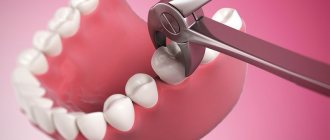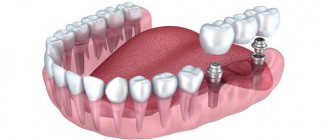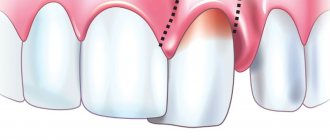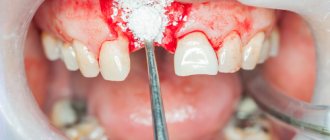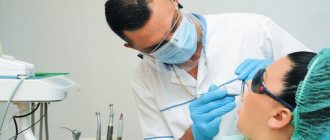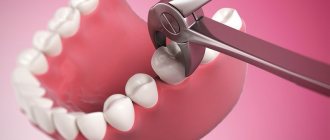Removing the 6th tooth is an operation that is performed quite often. Since sixes have rather deep fissures, their complete cleaning is difficult, which provokes the rapid development of caries. Externally, such damage is difficult to determine. after all, a cavity can form under the enamel. The extraction procedure will allow you to avoid the development of unwanted diseases, and if you follow the dentist’s recommendations, complications during the rehabilitation period.
Indications and contraindications for molar tooth extraction
It is impossible to determine the indications for the removal of molars in absentia; this requires an examination by an experienced dentist. Recommendations for carrying out extraction are:
- purulent periostitis when it is impossible to drain exudate through the root canal, abscess, phlegmon;
- purulent-inflammatory periodontal diseases, cystic formations, the presence of a tumor;
- longitudinal axial fracture of the dental crown, pulp exposure;
- destruction of the crown, excluding its reconstruction;
- incorrect position of the tooth, as a result of which the mucous membrane is injured or it is impossible to install an orthopedic prosthesis;
- diseases in which destructive changes in bone tissue occur;
- advanced inflammation of the paranasal sinuses, sinusitis.
There are the following contraindications for removal:
- exacerbation of cardiovascular diseases (pre-infarction condition, angina pectoris, arrhythmia, hypertension);
- acute respiratory viral diseases (including influenza and sore throat);
- general diseases of the body (renal failure, pancreatitis, infectious hepatitis);
- damage to the nervous system;
- the presence of neoplasms, hemophilia, leukemia, radiation sickness;
- the first and last months of pregnancy;
- inflammatory dental diseases (gingivitis, stomatitis);
- exhaustion of the patient’s body, dystrophy;
- alcohol intoxication.
Only a doctor has the right to make a decision about removal, carefully weighing all the pros and cons.
Operation stages
The six implant is installed in the classical way, as for all other lost teeth. Includes stages:
Preparation
Identification of contraindications, assessment of bone tissue and study of its size and density. Sanitation of the oral cavity, removal of plaque, treatment of gums and adjacent teeth. The stage lasts from several days to a month.
Bone tissue augmentation
If necessary, it is carried out as a preliminary stage in case of lack of bone tissue. The operation lasts an hour. After the planted material has fused with the bone (4-5 months), the artificial roots themselves are installed.
Installation of implants
The gum is peeled off, a bed is formed in the bone, an implant is placed, a plug is fixed, and sutures are applied. On the lower jaw, the implant takes 2-4 months to take root, on the upper jaw - 4-6 months.
Temporary prosthetics
At the patient’s request, lightweight plastic removable Butterfly immediate dentures are installed, which are attached to adjacent teeth.
Permanent prosthetics
The implant is opened, the plug is removed, the gum former is fixed, and after 10-14 days the abutment is installed. Impressions are taken and crowns are installed.
The sixth tooth implant can be placed immediately after removal into the resulting socket, but with a sufficient amount of bone tissue and under the following conditions:
- a pre-planned operation with the possibility of conducting diagnostics and assessing the immediate installation of an implant;
- atraumatic removal without damaging the alveolar process;
- absence of inflammatory and purulent processes at the root.
How the removal process occurs (video)
Before removing a diseased tooth, the doctor must take an x-ray to determine the location of the roots. Removal takes place with an anesthetic injection.
The doctor carefully separates the gum, grabs the tooth with forceps and begins to pull it out, rocking or twisting it, depending on the number of roots. After this, you can pull the tooth out of the alveoli. Removing the lower and upper teeth is not much different; the upper molars are somewhat more difficult to grasp correctly.
«
In more advanced cases, the doctor can divide the dental crown into pieces using a drill and tear them apart. This method helps protect the jaw from damage.
When removing an impacted tooth or root fragments, it is first necessary to cut the mucous membrane, free access to the dental crown, and then begin pulling out. This complex removal is often performed under general anesthesia.
Removal of a molar tooth with a cyst requires a highly qualified dental surgeon and is performed under both local and general anesthesia.
Two days after removal, it is necessary to examine the patient and do a control x-ray to exclude the presence of “forgotten” root fragments in the jaw.
Tooth structure
The teeth are located on the upper and lower jaws. They consist of hard and soft tissues.
Solid:
- tooth enamel – the outer shell that protects the tooth;
- dentin – hard tissue, the basis of the entire tooth;
- Dental cement is the tissue covering the neck and root of the tooth.
The soft pulp includes the loose tissue inside the dental cavity, which has a large number of vessels, both blood and lymphatic, and nerve endings.
Anatomically, a tooth can be distinguished into three parts:
- crown - the part protruding above the gum;
- root - a part located deep in the alveolus of the gum;
- neck of the tooth - part of the actual transition of the tooth enamel into cement, that is, the place in the gap between the root and the crown.
Is it painful to remove a molar tooth, pain after removal
The pain of extraction is a thing of the past - modern painkillers can make the process completely painless, even when removing a tooth with a nerve. The patient is more likely to be concerned about pain after removal.
It is impossible to unequivocally answer the question of how much the gums hurt after such traumatic manipulations. The pain is quite strong at first, but later it will be less intense.
The doctor will definitely recommend an effective pain reliever for the first time.
You should pay attention to the nature of the pain: if it intensifies, becomes “knocking”, tugging, this is a signal about the beginning of dangerous suppuration of the hole. You need to see a doctor as soon as possible.
Guarantees
In our Center, implants are installed with a lifetime warranty from the manufacturer - Nobel Biocare. We provide guarantees:
- lifetime for the installation of implants;
- 1 year for crowns.
The warranty program includes a complex for the implant, surgery, bone reconstruction and prosthetics.
The guarantee is valid provided that the patient follows the doctor’s recommendations, care rules and regularly visits the dentist.
Features of molar removal during pregnancy
During pregnancy, it is advisable to avoid any surgical interventions that negatively affect the condition of the expectant mother. Ideally, it is best to treat everything prophylactically before the onset of an interesting condition. If your tooth hurts while waiting for your baby, pay attention to the following points:
- Removal is not recommended in the first and last months, when the baby is most vulnerable.
- There is no need to expose the body to unnecessary stress, if we are talking about a planned operation, it is better to wait until the birth of the child.
- Any intervention should be carried out solely for health reasons.
- You definitely need to warn your doctor about your situation, he will select the most harmless anesthetic that does not penetrate the placental barrier.
If tooth extraction is complicated, it is advisable to do it in a hospital under the supervision of experienced doctors; during the first 2-3 days, the temperature may rise, which is extremely undesirable for expectant mothers.
Description of the procedure: how it is carried out
If the patient is undergoing a planned operation, then first he is sent for an X-ray examination and tests. After studying the diagnostic results, the doctor begins the procedure or prescribes it for the next free time. Complex extraction is recommended to be carried out at the beginning of the day. It is better not to eat or drink immediately before visiting the doctor - this will help enhance the effect of the anesthetic. If the patient suddenly catches a cold before removal, it is better to reschedule the procedure.
An X-ray examination is performed before removal.
First, the specialist administers anesthesia. If a simple operation is to be performed, its duration will be no more than 20 minutes. Using special forceps, the doctor carefully clamps the crown, rocks it with a special movement, and then sharply pulls it out of the socket. Lightly compresses the edges of the wound until the hole is completely filled with blood and a blood clot is formed - protection against infection and mechanical damage. Next, the doctor treats the injured tissue with an antiseptic, prescribes painkillers, and in some cases antibiotics, and gives detailed instructions about the postoperative period.
Molar tooth extraction in children
A child’s molar can be either a baby tooth or a permanent tooth; depending on this, treatment tactics are differentiated. If the permanent one has already begun to grow, and the milk tooth has not yet fallen out, but is already wobbly, the pediatric dentist will definitely advise removing the milk tooth that is interfering with normal eruption. If a baby’s permanent molar tooth hurts, the doctor will give preference to conservative treatment in order to preserve the integrity of the dentition.
Premature extraction of baby teeth is undesirable; it negatively affects the formation of the bite.
Clear indications for extraction in children are:
- the presence of a granuloma or dental root cyst.
- inflammation of the tooth root, mandibular nerve.
- complete destruction of the crown.
Symptoms of molar eruption
As a rule, the sixth teeth emerge from the molars first.
During the teething period, the immune system's defenses are weakened, and the following symptoms similar to colds may appear:
- elevated temperature;
- runny nose;
- and most importantly – increased salivation.
And since the teeth appear in pairs, that is, the canine on the upper right side erupts at the same time as the canine on the upper left side, then the six teeth in children come out together, which can aggravate the process.
These teeth are the very first molars to erupt. To ease the symptoms of a small child and relieve some of the pain, you can massage the gums with your finger, but be sure to wash your hands thoroughly before doing so. Otherwise, it will not be difficult to get an infection. And older children can chew hard vegetables or fruits: apples, carrots and other hard foods.
Possible consequences and complications
Extraction, like any operation, can cause a negative reaction from the body. If your cheek is swollen, your throat hurts, or there is a sharp throbbing pain in the socket, there is a high probability of an inflammatory process.
Early complications:
- fainting, shock, collapse;
- fracture, dislocation of the jaw;
- perforation of the maxillary sinus (when removing an upper molar or premolar), falling of root fragments into the gum;
- trauma, dislocation, fracture of an adjacent or opposite tooth;
- severe bleeding, hematoma formation.
Late complications:
- inflammation of the alveoli (alveolitis);
- inflammation of peripheral nerves (neuritis);
- restriction of jaw movement (muscle contracture).
By contacting a specialist in a timely manner, the consequences of removal can be minimized.
Is it possible to remove it at home?
Removing a tooth on your own is dangerous; at home, it is difficult to ensure sterility, numb the gums, ensure that the root is completely pulled out, and prevent blood loss and other complications. You can remove only a very loose tooth yourself without risk to your health.
Typically, children's loose baby teeth are removed at home. It is important to remove food debris and thoroughly disinfect the oral cavity. You need to tightly grasp the tooth with your fingers wrapped in sterile gauze, loosen it well and only then pull it. If after the second attempt you are unable to pull out the tooth, entrust this difficult manipulation to an experienced dentist without risking your health.
If the tooth comes out of the socket easily, you need to press the gauze swab firmly onto the wound to stop the bleeding and hold it for 30-40 minutes. You should refrain from eating for two hours.
If any unpleasant discomfort occurs, it is advisable to consult a dentist as soon as possible to prevent complications from developing.
Finally, I would like to remind you: simple preventive measures will allow you to keep your smile snow-white and your teeth healthy and strong for many years.
Free consultation on the cost of treatment in our dentistry
Leave a request and the clinic administrator will contact you within 15 minutes!
These teeth are often removed before installing braces to create free space in the rows. The fourth premolars have the shortest and smallest roots, so their removal is carried out quickly and without complications. In addition, these teeth bear less of the chewing load when eating food, and therefore their removal will cause much less harm to the health of patients than extraction of molars.
Removal of fifth premolars or “fives” before installing braces
They are removed before installing braces less often than eights and fours and usually when necessary, in order to obtain space for tooth displacement and preserve a maximum of chewing units.
The fifth premolars are larger in size than the fourth, however, the gap that remains after removing the “five” will not be noticeable either when smiling or when talking. Less commonly, teeth included in the smile zone, incisors, and seventh molars are removed before installing braces. Their removal before installing braces is carried out only if the patient has absolutely healthy wisdom teeth, which will be able to take on the entire load and efficiently perform the chewing function. Guessing which tooth may be removed in your case if you decide to install braces is generally useless. Firstly, this procedure may not be needed at all, and secondly, you need to take into account the malocclusion that needs to be eliminated. Only a specialist, an orthodontist, can assess the condition of your teeth, accurately determine bite defects and decide whether teeth need to be removed before installing braces. And not after one examination, but after a thorough and detailed diagnosis!
If you want to get advice from an experienced orthodontist on the treatment of malocclusion with braces, please contact our dental clinic in Moscow - Vanstom. To make an appointment with our specialists, you just need to dial the contact phone number of our dentistry or write to the chat on our website!
Tooth extraction before installing braces: how does this procedure affect the treatment time?
Correction of malocclusions with braces requires fairly long treatment periods.
Will this time be longer if you have to have teeth removed before getting braces? The answer to this question will be: in most cases, tooth extraction speeds up the course of treatment and allows you to wear braces less. After all, if there is free space in the row, the teeth will move and align faster. Calculate the cost of treatment by taking a short test in 20 seconds!
Do not delay your treatment, because in this matter time plays against us.
How quickly will a dental defect left after tooth extraction be closed? Patients also often ask dentists this question. On average, the gaps when wearing braces close at a rate of one millimeter per month, and therefore the smaller the tooth removed, the faster the defect will become invisible. It is worth considering that the rate of displacement of teeth in rows will also depend on the type of braces that will be used in the course of correction.
Is it possible to refuse tooth extraction and still undergo braces treatment?
In some cases, installing braces without first removing teeth will not allow the treatment to be effective and restore normal bite.
It is important to understand that in order for crooked teeth and crowding to disappear, the teeth must begin to shift and align. But these processes require free space in the dentition. If this place does not exist, there will be no result in treatment. Of course, the prospect of having teeth removed is not pleasant. But modern dentistry allows you to carry out this procedure without pain and quickly, and in addition, after completing treatment with braces, your teeth will become straight, beautiful, and the gap from the extracted tooth will be completely closed. This result is definitely worth some sacrifices!
You can find out more useful details about treatment with braces on the website of our dentistry in Moscow “Vanstom”: we have feature articles and news and, in addition, you can always ask our specialists a direct question by simply writing to us in the chat! You can also come to our clinic at any convenient time: we are located next to the Baumanskaya metro station and will always be happy to answer all your questions about treatment and maintaining dental health!


